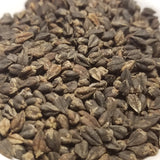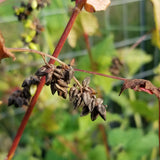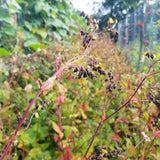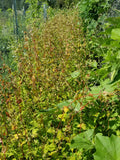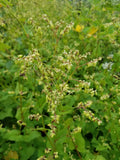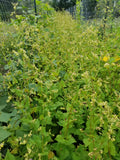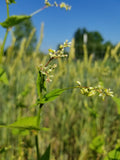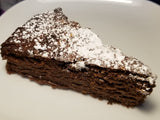(Fagopyrum tataricum); aka Green Buckwheat; Kernels have hulls
Tartary buckwheat is similar to common buckwheat (F. esculentum) but is more frost tolerant. Its seeds are slightly smaller and contain more of the anti-inflammatory compound rutin. Also the hulls grind more easily as they are a bit softer than that of common buckwheat. Interestingly, buckwheat is a pseudo-cereal, not a true relative of wheat or other cereals since it isn't in the grass family. This multi-use plant deserves a place in your garden. Tea is made by steeping its flowers and the greens (stems and leaves) are delicious in stir-frys or steamed. Seeds, rich in complex carbohydrates, are commonly sprouted. Once the hulls are removed the seeds are roasted for kasha or ground into flour. Buckwheat flour has a myriad of uses - for porridge, flat breads, pancakes, and soba. We grow buckwheat as a weed-smothering barrier crop, harvesting the seeds in the fall as they darken.
Easy to thresh, buckwheat kernels require de-hulling if you want to use the grains whole. Transform buckwheat kernels into a versatile gluten-free flour using this method. Be sure to try our favorite buckwheat pancake recipe or this amazing buckwheat flour chocolate cake recipe.
For more insight on the nutritional value of Tartary buckwheat see the 2021 article Tartary Buckwheat in Human Nutrition.
Tartary buckwheat was once used as an ingredient of scratch feeds for poultry. The small, smooth, rounded seed of tartary are better sized for the birds than the larger Japanese buckwheat seeds.
Buckwheat is one of the few plants specifically planted for a honey crop. It is written that 1 acre will yield 150 pounds of honey in the right conditions. Pollinators LOVE this plant! Additionally, our turkeys LOVE buckwheat and will jump fences to reach it when it sets its grains, making this a good food plot crop.
Culinary notes: Because Tartary is considered more bitter than Japanese buckwheat, pancakes and soba noodles are typically made with Japanese Buckwheat.
Here is interesting article about a large scale Tartary Buckwheat operation.








